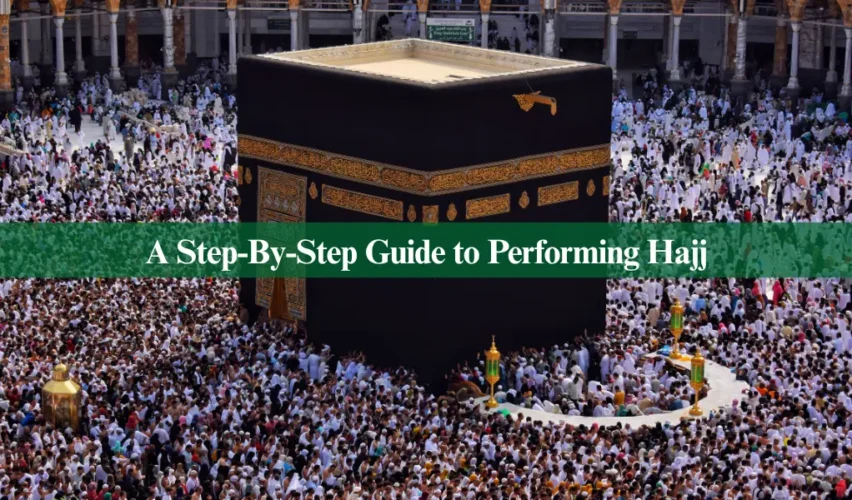Hajj is performed annually during eh Islamic month of Dhul-Hajj. It includes a series of specific rituals or steps known as Manasik-e-Hajj. Each step signifies submission, humility, and remembrance of Allah (SWT). Every ritual connects the pilgrim to the legacy of Prophet Ibrahim (AS) and the teachings of Prophet Muhammad ﷺ. From donning the Ihram to performing Tawaf, it’s not just a physical journey but a spiritual transformation. This step-by-step guide outlines all the Manasik-e-Hajj in detail. Read along and prepare yourself mentally, physically, and spiritually for a Hajj that is accepted, meaningful, and in accordance with Islamic teachings.
How Many Rituals of Hajj are There?
There are nine main rituals of Hajj, also known as Manasik-e-Hajj. Each of these carries a specific meaning and spiritual symbolism. Moreover, the fundamental rituals of Hajj (pilgrimage) include the following:
- Entering into Ihram
- Staying in Mina
- Standing at Arafat (Wuquf)
- Spending the night in Muzdalifah
- Rami al-Jamarat (stoning the pillars)
- Animal sacrifice (Qurbani)
- Shaving or trimming the hair (Halq or Taqsir)
- Tawaf al-Ifadah
- Tawaf al-Wida (farewell Tawaf).
These rituals or steps of Hajj are based on the actions of the Prophet Muhammad ﷺ. As it is referred in Hadith, he once said:
“Learn your rituals from me, for I do not know whether I shall be performing Hajj after this year.” – Sahih Muslim, Hadith 1297.
Your Ultimate Guide to the Rituals of Hajj
Are you performing Hajj this year? It’s an absolute privilege to pay your visit to the House of Allah. Truly, it is a once-in-a-lifetime spiritual journey. This guide will walk you through each step of the sacred pilgrimage. Keep reading to have a roadmap for knowledge, devotion, and complete peace of mind during Hajj.
-
Ihram
The journey of Hajj begins with Ihram. You should know that entering into ihram means entering a state of spiritual purity and sacred commitment. Moreover, pilgrims enter into Ihram on the 8th of Dhul-Hijjah (Yawm al-Tarwiyah) from a designated boundary point called a Miqat. For example, pilgrims coming from Madinah typically wear Ihram at Dhu’l Hulayfah (Abyar Ali). Ihram signifies equality, humility, and submission to Allah (SWT), uniting all pilgrims in devotion. This sacred state marks the official beginning of your Hajj.
Steps to enter the Ihram:
Muslims are obliged to follow a set of steps when wearing the Ihram for Hajj. Here’s an overview of how you should do it:
- Perform Ghusl (ritual purification), trim nails, and wear unscented clothing.
- Men wear two unstitched white cloths; women wear any modest, non-scented attire that covers the body.
- Make Niyyah (intention) for Hajj by saying:
“Labbaik Allahumma Hajjan.”
- Recite the Talbiyah frequently:
“Labbaik Allahumma Labbaik, Labbaika Laa Shareeka Laka Labbaik…
لَبَّيْكَ اَللَّٰهُمَّ لَبَّيْكَ، لَبَّيْكَ لَا شَرِيكَ لَكَ لَبَّيْكَ، إِنَّ الْحَمْدَ وَالنِّعْمَةَ لَكَ وَالْمُلْكَ لَا شَرِيكَ لَكَ. ”
- Once in Ihram, avoid all prohibited acts: no perfume, shaving, cutting hair/nails, hunting, or marital relations.
-
Mina (Yawm al-Tarwiyah)
On the 8th of Dhul-Hijjah, also known as Yawm al-Tarwiyah, pilgrims proceed to Mina. It is a tent city approximately 8 kilometers from Masjid al-Haram. This day marks the formal start of the Hajj rituals after wearing the Ihram.
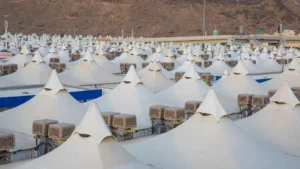
Mina is called the “tent city” because it is home to thousands of large, white, air-conditioned tents that accommodate millions of pilgrims during the Hajj. These tents provide shelter, safety, and comfort. They allow pilgrims to rest and perform their rituals in an organized and secure environment.
What to Do in Mina?
Pilgrims remain in Mina in a calm and reflective state. This is the time when they focus on spiritual growth. This step echoes the Prophet Muhammad’s ﷺ actions during his Farewell Pilgrimage. Moreover, here is what pilgrims do during their stay in Mina:
- Depart for Mina after Fajr prayer.
- Stay the entire day and night. During this time, they perform five daily prayers (Dhuhr, Asr, Maghrib, Isha, and Fajr) shortened (Qasr) but not combined.
- Use your time in dhikr (remembrance of Allah), reading the Quran, making duas, and mentally preparing for Arafat the next day.
Quick Question:
What is Yawm al-Tarwiya?
Yawm al-Tarwiyah, observed on the 8th of Dhul-Hijjah, is the first official day of Hajj. On this day, pilgrims travel to Mina, where they perform shortened prayers and prepare spiritually for Arafat. Pilgrims collect water and other provisions in Mina before heading to Arafat the following day. The word “Tarwiyah” means “to quench thirst”. The name represents the pilgrims’ preparation for the intense rituals ahead.
-
Arafat (Yawm al-Arafah)
The 9th of Dhul-Hijjah, known as Yawm al-Arafah, is the most important day of Hajj. After Fajr prayer, pilgrims leave Mina and travel to the plain of Arafat. Upon arrival, many attend the Khutbah of Hajj at Masjid Namirah. It is a powerful sermon that reminds pilgrims of their duties and spirituality.
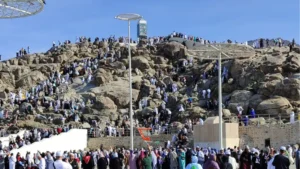
The central ritual during this step is Wuquf at Arafat. It refers to standing in prayer, reflection, and deep supplication from Dhuhr to Maghrib. For this, Pilgrims combine the Dhuhr and Asr prayers. This standing is considered the climax of the Hajj. The significance of Arafat was mentioned by Prophet Muhammad ﷺ himself. As he said:
“Hajj is Arafat.” – Tirmidhi
This day symbolizes forgiveness, mercy, and spiritual rebirth. It’s recommended to continuously make dua, seek forgiveness, and meditate on Allah’s mercy.
-
Muzdalifah
After sunset on the Day of Arafat, pilgrims leave for Muzdalifah (Night of 10th Dhul-Hijjah). You should know that it is a plain located between Arafat and Mina. Pilgrims do not pray Maghrib in Arafat but combine Maghrib and Isha prayers upon arriving in Muzdalifah.
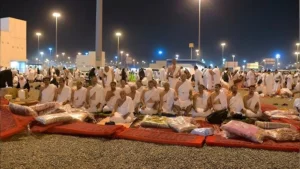
One of the key tasks here is to collect pebbles (usually 49 or 70), which will be used for the ritual stoning of the Jamarat (pillars) in Mina. This pebble collection is essential, so pilgrims should gather enough small, smooth stones. Muzdalifah is also where pilgrims spend the night resting under the open sky. Despite the physical exhaustion, this night is an opportunity for sincere prayer and reflection before returning to Mina for the next day’s rituals.
-
Eid Day (Yawm al-Nahr)
The 10th of Dhul-Hijjah, also known as Yawm al-Nahr (the Day of Sacrifice). This day is not only Eid al-Adha for Muslims around the world. In fact, it is also the most action-filled day of Hajj. Pilgrims perform four major rituals on this day, each with great spiritual and symbolic value. Here is a detailed overview of all these steps:
a. Rami al-Jamarat – Stoning Jamrah al-Aqabah
The first major ritual on Eid day is Rami al-Jamarat. For this, pilgrims start their day by throwing stones at the largest pillar, Jamrah al-Aqabah. This symbolic act represents Prophet Ibrahim’s (AS) rejection of Shaytan. It signifies the believer’s personal battle against evil temptations and reaffirms commitment to righteousness, obedience, and faith in Allah’s guidance.
- Throw 7 small pebbles, collected the night before in Muzdalifah, one at a time.
- With each throw, recite: “Allahu Akbar” (Allah is the Greatest).
b. Qurbani – Animal Sacrifice
Following the stoning, pilgrims perform the Qurbani, or animal sacrifice. This commemorates Prophet Ibrahim’s (AS) readiness to sacrifice his son in submission to Allah’s will. The act reflects obedience, gratitude, and compassion. The meat is distributed among the poor. This ritual reinforces the values of charity and community upliftment that Hajj teaches every believer.
- This is obligatory for those performing Hajj al-Tamattu’ or Hajj al-Qiran.
- Most pilgrims arrange the sacrifice through authorized Hajj agencies or online services.
c. Halq or Taqsir – Shaving or Shortening Hair
After the sacrifice, pilgrims undertake Halq (shaving) or Taqsir (trimming) of hair. This act symbolizes humility and renewal. It marks a physical transformation that reflects the pilgrim’s spiritual purification and rebirth. This act concludes the major rites of the 10th Dhul-Hijjah.
- Men are encouraged to shave their heads completely for greater reward.
- Women cut a fingertip-length of hair.
This marks physical and spiritual renewal, as the pilgrim begins a new chapter free from sin.
d. Tawaf al-Ifadah (May be delayed)
Tawaf al-Ifadah is a core pillar of Hajj and represents the spiritual climax of the pilgrimage. Pilgrims return to the Kaaba in Makkah to perform this special circumambulation. It reflects closeness to Allah and the internal transformation achieved through Hajj. Though ideally done on the 10th, it can be delayed until the end of the pilgrimage.
- Complete 7 rounds of Tawaf around the Kaaba.
- Followed by 2 rakats of prayer behind Maqam Ibrahim.
- Can be performed anytime on the 10th or during Tashreeq days (11th–13th).
Tawaf al-Ifadah is Fard (obligatory) and signifies the purification and completion of the Hajj rites.
6. Days in Mina (Ayyam al-Tashreeq)
After the Day of Sacrifice, pilgrims stay in Mina for two or three days, known as Ayyam al-Tashreeq (11th-13th Dhul-Hijjah. These days focus on continuing Rami al-Jamarat, along with worship, reflection, and gratitude. It’s a time to purify the soul, strengthen faith, and remain engaged in remembrance of Allah while following the routine of the Prophet ﷺ.
Daily Rami of the Three Jamarat
As aforementioned, each day, pilgrims throw 7 pebbles at each of the three Jamarat (pillars). They are named as follows:
- Jamrah al-Sughra (small)
- Jamrah al-Wusta (middle)
- Jamrah al-Kubra (al-Aqabah) (large)
- Begin after Zawal (midday) and continue until sunset.
- Say “Allahu Akbar” with each throw.
These days are for reflection, worship, and consistent dhikr, dua, Talbiyah, and Takbir.
Leaving Mina (Nafrah)
Nafrah refers to the departure from Mina after completing the rituals of Rami during the days of Tashreeq. Here is the significance of Nafrah for Hajj and pilgrims.
- Pilgrims may leave Mina on the 12th after performing Rami if done before sunset.
- Those who stay for the 13th perform Rami again.
Staying the full three days is preferred and shows increased devotion.
7. Tawaf al-Ifadah (If Not Yet Performed)
Tawaf al-Ifadah is one of the essential pillars of Hajj and must be completed for the pilgrimage to be valid. If not performed on the 10th, it should be done before leaving Makkah. This sacred circumambulation of the Kaaba symbolizes spiritual rebirth and the pilgrim’s renewed commitment to Allah. It is a powerful act of devotion and gratitude.
- Perform 7 circuits of the Kaaba in a counter-clockwise direction.
- Pray 2 rakats behind Maqam Ibrahim after Tawaf.
- It can be combined with Sa’i if not done earlier (for Hajj al-Tamattu’).
This Tawaf symbolizes the pilgrim’s spiritual rebirth and connection with Allah at the end of the major rites.
8. Sa’i between Safa and Marwah
After performing Tawaf al-Ifadah, pilgrims complete the ritual of Sa’I — walking between the hills of Safa and Marwah. These sacred hills are located within Masjid al-Haram. This rite re-enacts the struggle of Hajrah (AS), the wife of Prophet Ibrahim (AS), when she ran between the hills searching for water for her son, Isma’il (AS). It symbolizes patience, trust in Allah, and perseverance.
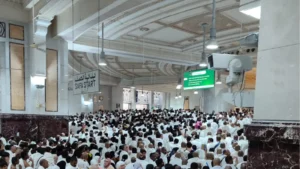
Steps for Sa’i:
The following is a step-by-step guide on performing Sa’i during Hajj.
- Begin at Safa hill, facing the Kaaba, and make dua:
“Indeed, Safa and Marwah are among the symbols of Allah…” – Quran 2:158
- Walk briskly between the green lights (men only), and continue at a normal pace otherwise.
- Complete 7 circuits, ending at Marwah.
- Engage in supplication, dhikr, and reflection throughout, remembering Allah’s mercy and the trials of Hajrah.
If performing Hajj al-Tamattu’, Sa’i must be done after Tawaf al-Ifadah. For Hajj al-Qiran or Ifrad, it may have been done earlier with the arrival Tawaf, depending on scholarly opinion.
9. Tawaf al-Wida – Farewell Tawaf
The final ritual of Hajj is Tawaf al-Wida, the Farewell Tawaf, which marks the pilgrim’s departure from the holy city of Makkah. This act signifies bidding farewell to the Kaaba and showing respect and gratitude for completing Hajj. It is obligatory (Wajib) for all non-residents of Makkah.
Guidelines for Tawaf al-Wida:
The following are a specific set of guidelines pilgrims must follow while performing Tawaf-al-Wida.
- Perform 7 circuits around the Kaaba in the usual counter-clockwise direction.
- There is no Sa’i required after this Tawaf.
- Make dua and seek forgiveness during each round.
- It should be the last act before leaving Makkah—avoid shopping or sightseeing afterward unless absolutely necessary.
The Prophet Muhammad ﷺ said:
“Let none of you leave Makkah until he makes Tawaf around the Kaaba as the last of his deeds.” – Sahih Muslim
Tawaf al-Wida reminds pilgrims of the spiritual transformation they’ve undergone and encourages them to carry that change forward in their lives.
Performing the Manasik-e-Hajj is a special journey that brings a person closer to Allah. Each step has deep meaning and teaches patience, faith, and devotion. By completing these rituals with sincerity, pilgrims return with a clean heart and soul. May Allah accept everyone’s Hajj and make it a source of blessings and guidance for life.
Prerequisites Before Hajj
Preparing for Hajj starts long before Hajj itself. After all, it requires thoughtful planning and careful attention to both practical and spiritual needs. Make sure you tick off all prerequisites so your journey is smooth and meaningful. Below are the essential preparations every pilgrim should complete beforehand:
-
Valid Passport and Hajj Visa
Your passport must be valid for at least six months from your travel date to Saudi Arabia. Securing a Hajj visa is mandatory and should be obtained through authorized Hajj operators or the official Ministry of Hajj channels in your country. Without this visa, entry to perform Hajj is not permitted, so timely application is crucial.
-
Required Vaccinations
The Saudi Ministry of Health requires pilgrims to have certain vaccinations before traveling. The meningitis vaccine (ACWY) is compulsory, while seasonal influenza and COVID-19 vaccines are strongly recommended based on current health guidelines. Carrying your vaccination certificates is important, as they will be checked during travel and upon arrival.
-
Ihram Garments
Before entering the sacred state of Ihram, pilgrims must have the appropriate clothing. Men wear two unstitched white sheets. One of them is wrapped around the waist, and the other draped over the shoulder. Women should dress modestly in loose-fitting clothing that complies with Islamic guidelines. It’s best to bring extra Ihram garments to maintain cleanliness throughout your rituals.
-
Basic Knowledge of Hajj Rituals and Duas
Understanding the steps of Hajj and memorizing essential duas enhances your spiritual experience and helps avoid mistakes. Studying the Manasik-e-Hajj in advance allows you to perform each ritual with confidence and devotion. Many pilgrims find it beneficial to attend Hajj workshops, follow trusted guides, or use reliable apps to prepare.
-
Financial and Family Preparation
Completing your Hajj journey without financial strain is important. Make sure your travel and living expenses are covered without incurring debt. Also, organize support for your family during your absence and settle any outstanding obligations or debts beforehand. Some pilgrims also prepare a wasiyyah (Islamic will) to ensure their affairs are in order.
-
Additional Practical Tips
Carrying multiple copies of your identification documents, flight tickets, and emergency contact numbers helps prevent complications during travel. Joining a registered Hajj group or guide can ease navigation through complex rituals and crowded places. Pack unscented toiletries, any necessary medications, and prayer essentials to stay comfortable and focused throughout your pilgrimage.
Some Tips for a Safe & Spiritual Hajj
Hajj is both a physical and spiritual journey. It requires preparation, patience, and awareness. With millions of people gathered in one place, staying safe, healthy, and spiritually connected is essential. These tips will help you manage the physical demands of Hajj while making the most of its deep spiritual rewards.
-
Stay Hydrated & Rest Often
The Saudi heat can be intense, especially during Dhul-Hijjah. Always carry a refillable water bottle and drink regularly. Rest whenever possible, especially after long walks between rituals.
-
Be Patient and Calm
You’ll face long queues, crowded areas, and delays. Accept these moments as part of the Hajj test. Remind yourself that patience is a form of worship.
-
Stay Spiritually Focused
Avoid unnecessary conversations, distractions, and social media. Use your time to read Qur’an, make dhikr, and reflect on the purpose of Hajj — to seek Allah’s mercy and forgiveness.
-
Wear Comfortable Footwear
You’ll be walking long distances. Choose breathable, comfortable shoes or sandals that meet Ihram guidelines. Avoid new shoes that haven’t been broken in.
-
Keep Personal Hygiene a Priority
Carry unscented wipes, hand sanitizer, and tissues. Stay clean and refreshed, especially during Ihram. Maintaining cleanliness is not only sunnah but also prevents illness.
-
Pack Smart and Light
Bring only essentials like travel-sized unscented toiletries, medications, basic clothing, and a prayer mat. A lightweight backpack can help you carry what you need without a burden.
-
Know the Ihram Rules
Familiarize yourself with what is allowed and prohibited in the state of Ihram. Avoid common mistakes like using scented products or arguing.
-
Follow the Group or Guide
Stick with your group, especially during transitions between Mina, Arafat, and Muzdalifah. Keep emergency contact numbers and your ID with you at all times.
-
Take Health Precautions
Make sure you’re vaccinated as required by Saudi regulations. Carry basic medications and any personal prescriptions. Protect yourself from heatstroke by using an umbrella or hat outside the Ihram.
-
Respect Others and Help When You Can
The best Hajj experience comes with good character. Be gentle, offer help, give way, and remember: Allah rewards even the smallest acts of kindness during this sacred journey.
Common Mistakes to Avoid During Hajj
As a pilgrim, you should make sure each step is done correctly is very important. However, due to tiredness, crowds, or lack of knowledge, some common mistakes can occur. Knowing these in advance can help you stay alert and avoid missing key parts of your Hajj. Here are some of the most frequent mistakes you should not make:
Missing Wuquf at Arafat
The stay at Arafat (Wuquf) is the most essential part of Hajj. Missing this stay – even by accident – invalidates the Hajj. Pilgrims must ensure they are within the boundaries of Arafat at any time between midday and sunset on the 9th of Dhul-Hijjah.
Not Collecting Enough Pebbles
Pebbles are needed for three days of Rami (stoning the Jamarat). Pilgrims often forget to collect enough from Muzdalifah. You need at least 49 pebbles (plus some extra in case some fall). It’s better to prepare in advance to avoid stress during the days in Mina.
Delaying Rami Until After Sunset (Without Valid Reason)
Rami (stoning the pillars) should be done after Zawal (midday) and before sunset. Delaying it without a valid excuse (like illness or overcrowding) may result in having to offer a dam (sacrifice). Always follow the timing guidelines and your group leader’s instructions.
Forgetting Tawaf al-Wida
Tawaf al-Wida (Farewell Tawaf) is mandatory for non-residents of Makkah. Many pilgrims either forget or delay it and then engage in shopping or other activities before leaving. It must be the last act before departure. Missing it requires a sacrifice unless there’s a valid excuse.
Using Scented Products in Ihram
While in Ihram, the use of any scented product, like perfume, soap, lotion, or deodorant, is strictly forbidden. Accidentally applying them can lead to a penalty (dam). Always pack unscented toiletries and double-check before using anything.
Conclusion
Performing Hajj is not just an obligation. In fact, it is a privilege to be at Kabaah and partake in this profound spiritual journey. It is a chance to cleanse the soul, renew faith, and demonstrate complete submission to Allah (SWT). Each step of the pilgrimage teaches invaluable lessons of patience, humility, and unity among Muslims worldwide. The above guide has you covered for all the fundamental rituals of Hajj. With this step-by-step guide to perform Hajj, you can have a thorough understanding of what the itinerary of Hajj is usually like. This way, you’ll be able to prepare for a smooth and hassle-free journey. May your Hajj be accepted, your efforts rewarded, and your heart filled with peace and blessings.

